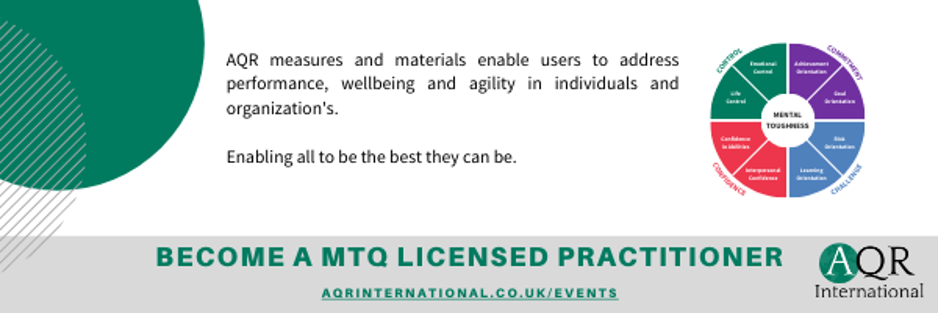How the mental toughness concept is taking us to a new level of understanding.
How have we got here?
Over the past 80 years or so, we have witnessed a major shift in the approach to people and organisational development. Particularly in the value of understanding what personality is and applying it in selection and development.
One approach has proved to be very popular – the idea that we can categorise people into types or classes. An idea that has some immediate appeal, it is simple to grasp and at one level, represents an advance from ideas that were held in the early part of the 20th Century.
It has spawned a number of instruments which use abbreviations or colours or labels to describe each type. Upon completion of a questionnaire, you can be assigned to a type and the characteristics associated with that type then became a broad description of behavioural aspects of your personality.
Exponents argue that this is a good way to introduce the idea of personality to those who don’t yet understand it.
Maybe? It can help to begin that process of understanding personality but, today, we can often see that it can also get in the way of fully understanding personality.
What are we now learning about personality?
It’s not a surprise that generally we have developed, over time, a much better understanding of personality and its many facets. Two words have begun to enter our vocabulary more frequently – complexity and nuance.
We know implicitly and explicitly, for instance, that people are incredibly complex and subtly different to each other. People are not simple and cannot realistically be allocated to boxes. Complexity means that we are all different – the world of psychology addresses the idea in the domain of “individual differences”. This means that even if we are similar, the differences matter in terms of performance, and wellbeing. So, nuance matters.
In fact, there are currently around 8 billion people on this planet. It seems incredibly unlikely that they are conveniently grouped in 2, 4 or 16 types of person. Even if there are 16 types, that means there are 500 million people on Earth with the same personality type as you. In truth, I don’t think I’ve ever met two of the same personalities.
Moreover, personality, which essentially describes our default response to what happens to us and around us, is also complex. In reality, most of the time when practitioners talk about personality, they are often talking about one dimension of personality – behaviour. Sometimes they are also talking about emotional responses.
It’s not a surprise that, in general, we focus on behaviour. It’s the most visible aspect of our personality. Which of course explains why a good deal of the original research on personality focused on this aspect. We can see how others behave and we can often assess and describe our own behaviour.
It is important. The appropriateness of our behaviour matters in a great many settings in most people’s lives.
Nevertheless, this has limitations. We can behave quite differently in different settings. Behaviour is often situational. It’s not a surprise that we can behave differently at work, at home or when engaged in the sport of some area of interest.
It appears that this behavioural aspect of personality is more fluid than typing can comfortably accommodate.
So perhaps typing approaches which put the individual in a box are limiting when it comes to understanding your personality. Especially where the individual is left believing that “this is what my personality is”.
And this is a major shortcoming of the typing approach
Of course, there have been advances in understanding behaviour. Possibly the most widely accepted description is provided through the so-called Big 5 concept. This is reasonably well researched although it too has its critics. The Big 5 factors are:
THE BIG 5 PERSONALITY MODEL
| Openness to Experience | Describes the extent of curiosity, interest in new ideas and new situations |
| Conscientiousness | Describes the extent to which there is delivery of what has been promised, punctuality, tenacity and reliability |
| Extraversion | Describes the extent to which someone is at ease in engaging with others, being outgoing and sociable |
| Agreeableness | Describes the extent to which someone is cooperative and willing to compromise, is trusting and tolerant |
| Neuroticism | Describes the extent to which negative emotions such as anxiety, anger, depression, etc are experienced |
The Big 5 model is capable of addressing some of the complexity we need to consider. Importantly it has a good evidence base behind most it.
Behavioural personality addresses what is my default or typical behaviour in response to the situation I now face. It is useful to understand this and, through that, to predict how I will behave in the same or similar situations.
What can the mental toughness concept add to our understanding of personality?
There are other aspects of personality which address a more fundamental question – why do I behave the way I do.
A significant part of the answer lies in understanding my fundamental mental responses to what happens to me and around me. We call this mental toughness. Technically it is metacognition – how I think about thinking.
Our mental responses have a significant impact on our behaviours and on the extent to which we experience and display our emotions.
Our work on the 8-factor mental toughness concept has reinforced the need to understand individual differences in the way people respond and where they come from. These are shown below. Each factor represents an aspect of the “way you think” when something happens to you.
| MT Scale | What this means … what does MTQ assess … the 8 Factors |
| CONTROL | Life Control – Self-worth – I believe I control enough of my life to achieve what I need |
| Emotional Control – I can manage emotions and not allow them to influence what I do | |
| COMMITMENT | Goal Orientation – I have a sense of purpose and like to set goals for this |
| Achievement Orientation – I am minded to do what it takes to achieve my goals | |
| CHALLENGE | Risk Orientation – I welcome experiences – I see opportunity more than I see threats |
| Learning Orientation – I reflect and learn from all that happens – including setbacks | |
| CONFIDENCE | In Abilities – I believe in my abilities to deal with life – and will use my abilities |
| Interpersonal Confidence – I think I can comfortably engage with and influence others |
There are over 40,000 different ways that these 8 factors can combine to explain a set of behaviours. So, you could have a roomful of people who all have the same level of overall mental toughness, who broadly demonstrate the same behaviours (e.g reluctance to do a particular task) but everyone will have a different profile underpinning it.
And, in fact, we can add a layer of complexity. We can have different degrees/levels of mental toughness on each of the 8 factors.
Taking this into account there are over a million possible combinations of factors and levels – you likely really are one in a million!
We are, in reality, much more individual and more complex than we realise most of the time.
If we are to help others, and ourselves, to optimise how we respond to what we meet in life and in work, we need to understand “why we respond that way” and we need to grasp the significance of nuance.
Looking at personality through typing might usefully start that journey but there are now concepts, approaches and instruments that take us a lot further down that journey of self-awareness and, ultimately, contentment that we are all on so we can to be “the best version of ourselves that we can be.
P.S. Usefully there is now research which relates the mental toughness factors to four of the Big 5 factors described above.
For more information about Mental Toughness see www.aqrinternational.co.uk.
To learn how to be a licensed user of the mental toughness concept and the MTQPlus measure, contact headoffice@aqr.co.uk



